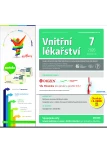A man with dysthymia (with negative evaluation of allmost all through his live) induced depression in his sensitive spouse
Authors:
Jeroným Klimeš 1; Zdeněk Adam 2
Authors‘ workplace:
Soukromá psychologická ambulance, Praha 9 – Újezd nad Lesy
1; Interní hematologická a onkologická klinika LF MU a FN Brno
2
Published in:
Vnitř Lék 2020; 66(7): 46-54
Category:
Case Report
Overview
Long lasting, low intensity depressive episodes have been diversely integrated according to the classifications types or the psychodynamic points of view. The concept of anxious persistent lasting depression, neurotic depressive states, neurotic depression have been unified into the dysthymic disorder category of the DSM classification. This concept unification have been a topic of dispute considering that dysthymic disorder was a restrictive, heterogeneous an extensively comorbid diagnosis. Nevertheless the definition of this category offers the opportunity to place the notions of temperament, personality, adjustment disorder. Including dysthymic disorders as a category inside of the mood disorders classification suggests the interest of using an antidepressive medication in presence of chronic depressive states not included in the major depressive disorder category. But the most important treatment is psychotherapy, because dysthymie is connected with pathologic cognition and interpretation of reality. This paper describes that dysthymia induced similar problems in the family members of dysthymic persons, and even induced somatic disorders in sensitive persons, as described in this paper.
Keywords:
dysthymia – anhedonia
Sources
1. Adam Z, Klimeš J, Pour L, et al. Maligní onemocnění, psychika a stres. Praha, Grada Publishing 2019 : 208 s.
2. Identification of dysthymia in neurological disorders: report on the meeting of principal investigators involved in the field trial „Classification of dysthymia and related conditions in neurological disorders“ Geneva: World Health Organization, 1998 : 14 s, 30 cm. Programme on mental health.
3. Patel RK, Rose GM. Persistent Depressive Disorder (Dysthymia). 2019 May 4. StatPearls (Internet). Treasure Island (FL): StatPearls Publishing; 2019 Jan-. Available from http://www. ncbi.nlm.nih.gov/books/NBK541052/.
4. Gureje O. Dysthymia in a cross-cultural perspective. Curr Opin Psychiatry. 2011; 24(1): 67–71.
5. Tamburrino MB, Lynch DJ, Nagel RW, et al. Primary care evaluation of mental disorders (PRIME-MD) screening for minor depressive disorder in primary care. Prim Care Companion J Clin Psychiatry. 2009; 11(6): 339–343.
6. Höschl C. Dysthymie – cíl specifické terapeutické intervence? Nový přístup v léčbě dysthymie. (Praha) : (Sanofi-Synthelabo s.r.o.), 2002: s 6–7.
7. Anders M. Dysthymie Practicus (Praha). 2005; 4(2): 46–48.
8. Michal Viewegh: Báječná léta pod psa. Petrov, Brno 2002.
9. Libigerová E. Dysthymie – trvalá afektivní porucha na pomezí poruch osobnosti a poruch nálady. Psychiatrie (Praha, Print). 2006; 10(1): 27–34.
10. Libigerová E. Dysthymie – diagnostika a léčba Psychiatrie pro praxi. 2006; 7(2): 90–93.
11. Praško J. Dysthymie: příručka pro klinickou praxi. Praha : Maxdorf, 2003 : 86 s.
12. Praško J, Herman E, Hovorka J. Dystymie a její léčba, Psychiatrie v medicíně a medicína v psychiatrii. 1. vyd. Praha, Galén, 2002: s 195–198.
13. Praško J, Herman E, Hovorka J. Dystymie a její léčba: Psychiatrie (Praha, Print). 2003; 7(Suppl. 2): 92–93.
14. Praško J, Sigmundová Z, Demlová B. Dystymie Klinická psychiatrie. 1. vyd. Praha: Tigis, 2011: s. 298–309.
15. Praško J, Herman E, Hovorka J. Dystymie a její léčba – 1. díl Psychiatrie pro praxi. 2002; 3(6): 265–270.
16. Praško J, Herman E, Hovorka J. Dystymie a její léčba – 2. díl Psychiatrie pro praxi. 2003; 4(1): 23–28.
17. Forgáčová Ľ. „Double“ depresia „ klinické charakteristiky a liečba. Psychiatrie pro praxi. 2003; 4(2): 60–61.
18. Douglas J, Olshaker M. Lovec duší. Překlad Josef Orel. Vyd. 1. Frýdek-Místek: Alpress, 1997 : 415, (8) s. il. Klokan. ISBN 80-7218-009-6. Online ukázka: http://klimes.mysteria.cz/ clanky/psychologie/douglas/douglas.htm
19. Klimeš Jeroným: Partneři a rozchody. Portál, Praha, 2005 : 240, ISBN 978-80-262-0575-3.
20. Schönknecht P, Hegerl U. Dysthymia. Fortschr Neurol Psychiatr 2012; 80(10): 602–608.
21. Brieger P. Subaffective disorders: dysthymia and cyclothymia. MMW Fortschr Med 2010; 152(3): 31–33.
22. Schmauss M, Messer T. Dysthymia. Fortschr Neurol Psychiatr 2005; 73(7): 415–424; quiz 425–426.
23. Klein DN, Santiago NJ. Dysthymia and chronic depression: introduction, classification, risk factors, and course. J Clin Psychol 2003; 59(8): 807–816.
24. Benca RM, Peterson MJ. Insomnia and depression. Sleep Med 2008; 9(Suppl. 1): S3–9.
25. Levkovitz Y, Tedeschini E, Papakostas GI. Efficacy of antidepressants for dysthymia: a meta-analysis of placebo-controlled randomized trials. J Clin Psychiatry 2011; 72(4): 509–514.
26. von Wolff A, Hölzel LP, Westphal A, et al. Selective serotonin reuptake inhibitors and tricyclic antidepressants in the acute treatment of chronic depression and dysthymia: a systematic review and meta-analysis. J Affect Disord 2013; 144(1–2): 7–15.
27. Thomayer J. Patologie a terapie nemocí vnitřních. Nakladatelství Bursík a Kohout, Praha 1893, 1921.
28. Filip L. Léčení chorob krevního oběhu. Vlastním nákladem, Poděbrady 1933 : 166 s.
29. Mohr P. Nová diagnostická klasifikace duševních poruch v 11. Revizi Mezinárodní klasifikace nemocí. Psychiatrie (Praha) 2020; 24(1): 32–38.
30. Riegel KD, Kalina K, Pěč O. Poruchy osobnosti v 21. století. Portál, Praha 2020 : 238 s.
31. Gastpar M, Kielholz P. Problems of psychiatry in general practice. Hogrefe & Huber, Toronto, Bern, Göttingen 1991 : 168 s.
32. Křivohlavý J. Jak si navzájem lépe porozumíme. Svoboda, Praha 1988 : 240 s.
33. Mahali SCh, Seshai S, Feeney JR, et al. Association of negative cognitions, emotional regulation, and depression symptoms across four continents: International support for the cognitive model of depression. BMC Psychiatry 2020; 20 : 18 https:// doi.org/10.1186/ s12888-01--2432-x.
Labels
Diabetology Endocrinology Internal medicineArticle was published in
Internal Medicine

2020 Issue 7
Most read in this issue
- Hypoglycemia in non -diabetic patients
- Metformin -associated lactic acidosis
- Coagulopathy associated with COVID-19
- CAR T-cells: hot news in cancer therapy
